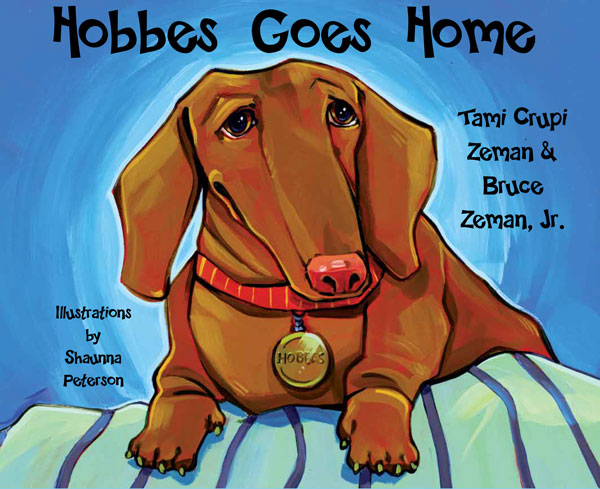Bruce Zeman was in the middle of a lot of things in November of 2009.
He was moving back to Vermont, buying a house, getting married, and creating a new morning radio show for 92.1 WVTK-FM, in Middlebury.
When he received a call from the Addison County Humane Society in Middlebury, Vermont, asking him to come look at a dachshund in bad shape, he was hesitant. Zeman wanted to help but wasn’t looking to add a dog to his new family. That changed, however, when Zeman – a nationally recognized animal rights activist, saw the dog and was truly shaken.
“He was bleeding from multiple places,” Zeman said. “He was covered in welts. He had chunks of skin missing behind his ears where he had beaten by women’s shoes.”
Zeman knew he could not leave the dog at the shelter, and sent pictures to his fiancée, Tami, who agreed with his initial assessment. Zeman then picked the dog up, and found his hands covered in the dog’s blood. He was filled with conflicting emotions of intense sadness, and rage, at the condition of the tiny dachshund. Regardless, the 3-year-old pup was coming home with him.
Zeman also became privy to information a “normal” adopter would not – the history of abuse the dog suffered. The pup had come from a horrific domestic violence situation – abused by a man and his children, and thankfully, turned in by the wife, who told Humane Society officials her husband had threatened to shoot the dog if he was in the home when the husband returned that night.
Zeman brought the dachshund home and named him Hobbes. The pup was terrified, but after a few days – knowing he was finally safe – Hobbes began to relax, and seemed to notice quickly, he had found his forever home.
Radio Response
The day after bringing Hobbes home, Zeman opened the mic on WVTK, and spoke to listeners about his new pup. He was surprised about the positive, and immediate response from listeners. About a week later, Zeman approached his Program Director, Gale Parmelee – known nationally for developing programming and air talent, and suggested making Hobbes part of the show. Financially, the station was struggling, so when Zeman pitched the idea of Hobbes becoming a co-host on the “Wake-Up Crew’” to Parmelee, he wasn’t sure what the response would be.

Zeman didn’t have to wait long for Parmelee’s response. “He loved the idea,” Zeman said.
And so, with Parmelee’s guidance, “The Wake-Up Crew with Bruce & Hobbes was born. Soon after, WVTK took off in ratings, listeners, and revenue. One other unexpected consequence, Zeman said, was because one of the show’s focuses was animal issues, the show started to be heard outside of the Green Mountain State.
As the show gained in popularity, Zeman was approached by people who wanted him to do more for animals, something he was unsure about, because of the effect it might have on the small dog, who, after suffering so much abuse had finally found a loving home.
Zeman began to grow concerned about Hobbes, and whether or not he was being exploited. “My primary concern is, and always has been, his welfare,” Zeman said. “Not ratings, not revenue, not generating interest. It is his well-being.”
Hobbes at the mic — Photo courtesy of Bruce Zeman.
For Zeman, this meant that if, for any reason, he felt Hobbes was not happy with his new role, he would remove him from it.
How would he find that out? Zeman would ask him – via an animal communicator.
“Believe it or not, we had an animal communicator come on the show, and we asked him,” Zeman said. “We got the answer, if you believe in that stuff.”
Through the communicator, Zeman found there were days when Hobbes didn’t want to go anywhere. On those days, Hobbes stayed home. While this presented a challenge at times, Zeman said once everyone realized Hobbes’s well-being was his top priority, the station embraced it.
“Hobbes Goes Home”
As the show continued to do well, and generate additional listeners and revenue, Zeman found himself, and Hobbes, being pulled into the national spotlight. An invitation to the National Animal Rights Convention in Washington D.C. led to additional, national speaking engagements for the duo, and the ultimate decision to write a children’s book, “Hobbes Goes Home,” which brought Hobbes’ story to the world.

Yet authoring a children’s book presented challenges: How to write a substantive story for kids touching on weighty topics like bullying, animal rights and domestic violence without terrifying them, and creating a book that would be well-received by parents, and others working with kids.
No easy task, but somehow, they did it.
Zeman wrote the book with his wife Tami. The duo elected to use subtleties and illustrations by artist Shaunna Peterson, who created memorable images. It took two years for everything to come together, and when the book was released in January 2014, Bruce & Hobbes hit the road on a national tour – the “Hobbes Goes Home” anti-bullying book tour.
“Our goal was (and still is) to eventually visit every elementary school in (Vermont),” Zeman said. Not an easy task, as there are over 400 elementary schools in the Green Mountain State. The duo is on their way though, and as of last count, Zeman and Hobbes have visited over 200 schools in six states, with many more visits scheduled. The profit on each book is about five dollars, which is donated to animal rescue and welfare organizations.
Bruce & Hobbes Radio
The success of their radio show, and the book, led Zeman to consider a new platform, “Bruce and Hobbes Radio,” a podcast about animal-related issues where Zeman (with Hobbes’ input, of course) discusses not only animal rights and issues, but also animal care, and welfare topics.
One troubling topic Zeman felt compelled to address was animal abuse, and the perceived, “lack of consequences,” for abusers. A prime example is former NFL quarterback Michael Vick, who spent 21 months in Federal prison after pleadng guilty to a felony charge stemming from his involvement in a dogfighting ring. After his release from prison, Vick was immediately signed by another NFL team. He retired from the NFL in 2017 and was offered, and signed, a contract as an analyst for FOX Sports.
When it comes to the NFL, Zeman doesn’t mince words.
“I think, overall, the NFL enables bad behavior,” Zeman said. “If you can run or throw a football, regardless of how terrible a behavior is, get a good lawyer, and PR person, and you’ll eventually get back on the field.”
Vick has publically stated that he has changed his ways and is even now an animal rights acttivist. But, has Vick really changed? Perhaps, but as Zeman points out, multi-million dollar contracts were waiting for Vick upon his prison release.
“So if you think about it,” Zeman said, “there wasn’t much of a consequence for (Vick). He went to prison, but then he came out, and millions of dollars were thrown at him because he could play football. What kind of message does that send? A bad one.”
A Connection – Violence against Animals and Violence against People
Zeman often brings up the connection between violence against animals and violence against people, and he’s not alone. A simple Google search on the subject spat out dozens of articles and the articles are not confined to animal rights or animal rescue sites. According to the FBI’s website, their National Incident-Based Reporting System (NIBRS) has been tracking animal abuse data since January, 2016, after being lobbied by various animal rights organizations and law enforcement agencies.
The National Sheriffs’ Association was a leading advocate for adding animal cruelty as a data set in the Bureau’s collection of crime statistics,” an article called “Tracking Animal Cruelty” states. “The association for years has cited studies linking animal abuse and other types of crimes—most famously, murders committed by serial killers like Ted Bundy, Jeffrey Dahmer, and the “Son of Sam” killer, David Berkowitz. The organization also points out the overlap animal abuse has with domestic violence and child abuse.
“’If somebody is harming an animal, there is a good chance they also are hurting a human,’ said John Thompson, deputy executive director of the National Sheriffs’ Association. ‘If we see patterns of animal abuse, the odds are that something else is going on.’”
“So when you talk about animal abuse not being an issue,” Zeman said, “you’re living in a dreamland if you don’t think it is a precursor for something else.”

For the Animals
A reflective Zeman said being involved in animal rescue can be disheartening because of the frequency and severity of the abuse cases. “Just when you think you’ve seen the worst people have to offer, somebody manages to go further,” he said.
At the same time, Zeman said he knows there are as many good people who care about animals, and wants to make the world better for them. That’s done by getting the word out.
“You know what we need?” Zeman said, “We need people to hear about Hobbes, his story, and Zoey, (another animal Zeman rescued) and her story.”
“This is what this story is about,” Zeman said. “Hobbes and Zoey, not me. I’m nobody important. We need people to hear and decide (that) compassion, empathy, and kindness is important. One person can make a difference though, and that one person could be you.”
More Information
For more information on Bruce Zeman, Hobbes, Zoey and “The Wake-Up Crew with Bruce & Hobbes,” or to purchase “Hobbes Goes Home” please visit the following websites:
https://www.facebook.com/BruceandHobbes/
http://www.921wvtk.com/show/bruce-hobbes/
https://www.facebook.com/HobbesGoesHome/
https://www.amazon.com/Hobbes-Goes-Home-Crupi-Zeman/dp/1939216176
